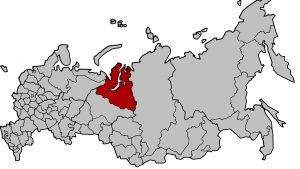By Taran Rai, CRRI Intern
Permafrost occupies over 65% of Russia’s territory and requires sub-zero temperatures to maintain its solid state. However, accelerating climate change is thawing the frozen soil of the arctic circle at unprecedented rates. As the frozen soil melts, it releases greenhouse gases like Methane and Carbon Dioxide that were trapped underground. These gasses change the composition of the atmosphere, leading to further global warming and driving a dangerous cycle of runaway thawing, greenhouse emissions, rising temperatures and further thaws.
One of the effects of the global warming in Russia is especially felt in Northern areas such as Norilsk, where melting permafrost led to infrastructure damage and an oil spill. The Washington Post reported that a fuel reservoir was ruptured, spilling “21,000 tons of diesel into fragile river ecosystems and wetlands”. The fuel could have severe environmental effects, including the extinction of endangered sea creatures native to Norilsk and lingering toxic chemicals in the topsoil. Currently, Russia is set to demand around €2bn in compensation for the disaster to cover cleanup and ecological restoration programs.
Melting permafrost couldn’t have occurred at a worse time for Russia, having already been hit hard by the COVID-19 pandemic and the subsequent economic recession. The 2035 strategy is likely a move from the Kremlin to reduce unemployment in the region and help support the remote and inaccessible cities north of the Arctic Circle before COVID-19, and is even more necessary in the current situation.
While the infrastructure damage as a result of climate change in Russia stands at €2bn according to S&P Global, it’s been estimated by The Telegram that Canada could incur “costs of climate change could represent about $5 billion per year by 2020 in Canada, and, depending on the levels of continued global emissions growth, could rise to $21 billion to $43 billion per year by 2050.” The financial and humanitarian implications of global warming related infrastructure damage both in Canada and Russia, as well as other northern countries, may unfold into the crisis of century.
Collapsing ice shelves leading to rising sea levels “could cause $14.2 trillion in [global] infrastructure damage this century if we don’t curb carbon emissions” according to Gizmodo. Climate-related infrastructure damage will likely become more prevalent for Canada in the near future as well, with other nearby ice caps like Murray and Simmons also in danger of irreversible harm. While melting sea ice has had a negligible impact so far, the melting of Murray and Simmons could lead to far more serious financial and ecological losses for the Arctic nation in the coming years. Russia, on the other hand, has a much larger presence in the Arctic circle and is much more vulnerable to the effects of thawing earth and rising sea levels.
To the world, climate change poses a potentially existential threat. Russia and Canada, as global leaders, have a duty to lead the fight against climate change to protect both themselves and other vulnerable nations around the world.




